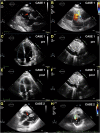Early cardiac unloading with ImpellaCP™ in acute myocardial infarction with ventricular septal defect
- PMID: 32043814
- PMCID: PMC7160491
- DOI: 10.1002/ehf2.12622
Early cardiac unloading with ImpellaCP™ in acute myocardial infarction with ventricular septal defect
Abstract
Despite a relative contraindication, mechanical support with Impella™ left ventricular assist device has already been described for ischaemic ventricular septal defect treatment, either as a bridge to surgery, as intraoperative mechanical haemodynamic support, or to ensure intraprocedural haemodynamic stability during device closure. We describe two cases of ventricular septal defect complicating acute myocardial infarction, where the percutaneous ImpellaCP was implanted early (differently than previously described) with the aim of preventing haemodynamic instability, while deferring surgical repair. We present a report of haemodynamic, echocardiographic, biochemical, and clinical data of two consecutive cases of ImpellaCP use, within a minimally invasive monitoring and therapeutic approach. In two cases of subacute myocardial infarction-related ventricular septal defect not amenable to percutaneous device closure, the use ImpellaCP was successful: it was followed by effective and rapid right and left ventricular unloading, by major haemodynamic instability prevention and protection from systemic venous congestion, from kidney and splanchnic organ failures. This allowed bridging to appropriately timed surgical repair. These cases suggest a potentially effective, clinically grounded strategy in the early management of ischaemic ventricular septal defect patients, with the aim of deferring surgery beyond the safer 7 days cutoff associated with a lower perioperative mortality.
Keywords: Acute heart failure; Acute myocardial infarction mechanical complication; Impella; Left ventricular assist device; Ventricular septal defect.
© 2020 The Authors. ESC Heart Failure published by John Wiley & Sons Ltd on behalf of European Society of Cardiology.
Conflict of interest statement
None declared.
Figures

References
-
- Singh V, Rodriguez AP, Bhatt P, Alfonso CE, Sakhuja R, Palacios IF, Inglessis‐Azuaje I, Cohen MG, Elmariah S, O'Neill WW. Ventricular septal defect complicating ST‐elevation myocardial infarctions: a call for action. Am J Med 2017; 130: 863 e861–863 e812. - PubMed
-
- Moreyra AE, Huang MS, Wilson AC, Deng Y, Cosgrove NM, Kostis JB, Group MS. Trends in incidence and mortality rates of ventricular septal rupture during acute myocardial infarction. Am J Cardiol 2010; 106: 1095–1100. - PubMed
-
- Jeppsson A, Liden H, Johnsson P, Hartford M, Radegran K. Surgical repair of post infarction ventricular septal defects: a national experience. Eur J Cardiothorac Surg 2005; 27: 216–221. - PubMed
-
- Ibanez B, James S, Agewall S, Antunes MJ, Bucciarelli‐Ducci C, Bueno H, Caforio ALP, Crea F, Goudevenos JA, Halvorsen S, Hindricks G, Kastrati A, Lenzen MJ, Prescott E, Roffi M, Valgimigli M, Varenhorst C, Vranckx P, Widimsky P, Group ESCSD . 2017 ESC Guidelines for the management of acute myocardial infarction in patients presenting with ST‐segment elevation: the task force for the management of acute myocardial infarction in patients presenting with ST‐segment elevation of the European Society of Cardiology (ESC). Eur Heart J 2018; 39: 119–177. - PubMed
-
- Rozado J, Pascual I, Avanzas P, Hernandez‐Vaquero D, Alvarez R, Diaz R, Diaz B, Martin M, Carro A, Muniz G, Silva J, Moris C. Extracorporeal membrane oxygenation system as a bridge to reparative surgery in ventricular septal defect complicating acute inferoposterior myocardial infarction. J Thorac Dis 2017; 9: E827–E830. - PMC - PubMed
Publication types
MeSH terms
LinkOut - more resources
Full Text Sources
Medical

